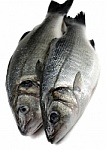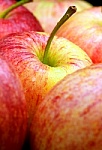I, like most people, enjoy playing cards. Unfortunately I don't play often enough, and it takes me a while to get my card chops back. Except for poker. I have the worst poker face ever. I'm guessing my pout and displeased expression must give away a bad hand. But if I have a good hand (and I always play with a little sheet my husband made me to remember what's what and what's higher) I'm like a dog being told that it's time for a walk. Tongue hanging out, tail wagging, I can barely contain myself. If I were a playing card, I'd be the joker.
Playing cards, like chess, are believed to have been invented in India. The oldest Indian cards were divided into ten suits representing the ten incarnations of the god Vishnu. They were round in shape and hand painted, and some even had thirty-two suits.
Ganjifa is a card game from Persia that was popular with the Mughals in 15
th century India, but it’s not clear which influenced which, ganjifa or Indian cards.
 |
Cards from a Dashavatara (Ten Avatars) Ganjifa set. From top left across:
6 white horses with parasols of the Kalki suit; four tigers of the
Narasimha suit; seven tortoises of the Kurma suit; 3 axes of the Parashurama
suit; minister on horseback of the Vamana suit; 3 ewers of the Vamana suit;
10 quivers of the Lakshmana suit; boar incarnation of the Varaha suit; 5 lotuses
of the Buddha suit; 6 peacock feather crown of the Taj (Crown) suit.
Rajasthan, India, 19th century, LACMA. |
 |
Chinese playing card
found near Turfan,
c. 1400 CE
Museum fur Volkerkunde |
Cards were found in China as early as the 9th century, during the Tang Dynasty (618-907 CE). Ancient Chinese cards have four suits, and feature ideograms. There is a suggestion that these early cards may have been a form of currency. Modern Mahjong tiles possibly evolved from these.
How playing cards got to Europe is debatable. Some say Marco Polo brought them back from China, but he seems to be the go-to guy for anything in Europe derived from Asia. Most references state the Saracens introduced them. They are mentioned in documents from the late 13th century in Europe. Charles VI of France bought three decks of cards we know from a receipt from 1392. (Mother always told me to save all receipts.) They became very popular, were taxed, and had import restrictions on them. There are some historians who claim that playing cards came from tarot cards, but the two types of cards developed independently. (The use of the tarot deck exclusively for divination is in the U.S. Other countries use the deck, usually with modifications, to play card games.)
The first cards were very expensive because they were made by hand. In the 15th century woodcuts were used to create printed decks. Most of these woodcut printed cards were hand colored. Soon engraved cards appeared, which was an even more expensive process. These are very collectable, as are playing cards in general, should you have too much money and wish to spend it on something. (I have other ideas in this regard - just email me.)
 |
The seven of hearts,
1803, from Metastasis, the first
complete set of transformed cards
published by John Nixon. |
 |
3 of cups, c. 1520
Topkapi Seray Museum,
Istanbul |
It wasn’t until 1832 that Thomas de la Rue invented a typographic process that was used in making cards, and the “double-headed” cards became the standard. These featured images that were duplicated in reverse, so they could be viewed from either end. This was an important feature since prior to that astute players would be able to figure out how many court cards a rival had when s/he turned them right side up.
There are currently various types of playing cards within the many countries that use them. The number of cards and suits differ; the English adopted the French deck. The French deck originated circa 1480 CE, with four suits: the trèfle, or club, mostly liked derived from an acorn; the pique, or spade, from the leaf used in German decks; hearts and diamonds, which are self-explanatory.
The court cards developed in the 15
th century, representing European royalty. Thus there were kings, queens, and knaves. The knaves were changed to Jacks in the 17
th century. Primarily this change occurred when indices were printed on the corners of cards, so the player could fan his/her holdings in one hand and know what cards were there. Since “K” (for king) and “Kn” (for knave) looked too closely alike, the change to “J” was thought to facilitate a quicker reading of the cards by the players.
In the earliest games the king was always the highest card, but in the 14th century the ace, then the lowest card, gained significance. It is believed that by the 18th century, the French Revolution cemented that ace high concept as a symbol of the lower class rising above royalty. The word ace was ultimately derived from the ancient Roman aes, the smallest unit of coinage.
 |
A vehicle for a political statement, this card of
the French Revolution symbolizes brotherhood.
During this time Kings, Queens, and Jacks became
Liberties, Equalities, and Fraternities, as a good
revolutionary wouldn't associate with royalty.
This concept was reversed with Napoleon. |
The U.S. introduced the joker into the deck, whose identity was similar to the fool in the tarot deck. It was devised for the game of Eucre, which was very popular in the 19th century. The name of the character is believed to have derived from juker, a different pronunciation of the game. The standard deck of 52 cards includes 13 cards of each of the four suits, plus two jokers, which are removed for most games. Although English or American decks differ from what is used in France, they are still considered French decks.
 |
Image of the 3 of clubs from a deck called
The Key to the Kingdom commissioned by
London's Victoria and Albert Museum of
Childhood, created by Tony Meeuwissen.
Set was published in 1992 and featured
nursery rhymes and poems. |
Even though some of the design elements of the cards are rarely used in games they are notable. The jack of spades, jack of hearts, and king of diamonds are featured in profile, and referred to as “one-eyed”. “Acey, deucey, one-eyed jack” means that aces, twos, and one-eyed jacks are wild cards. Since the king of hearts originally was the only king without a moustache and had a sword behind his head, it lead to his moniker of “suicide king”, or “false king”. On some decks a closer look reveals that there are four hands, and the sleeves of the arm holding the sword don’t match his, meaning he is being murdered. It turns out it is the arm of the queen of spades. The explanation for this card seems to be lost. There are many theories about just who these royal cards represent, but today’s cards have been distorted and carry no significance. The following are some of the traditional references to the royal cards:
King of Spades David
King of Hearts Charles (possibly Charlemagne, or Charles VII)
King of Diamonds Julius Caesar
King of Clubs Alexander the Great
Queen of Spades Pallas
Queen of Hearts Judith
Queen of Diamonds Rachel
Queen of Clubs Argine (possibly an anagram of regina, which is Latin for queen,
Knave of Spades Ogier the Dane/Holger Danske (a knight of Charlemagne)
Knave of Hearts La Hire (comrade-in-arms to Joan of Arc/member of Charles VII's court)
Knave of Diamonds Hector
Knave of Clubs Judas Maccabeus, or Lancelot
Again, there are many other decks. A 32-card deck is known as a piquet deck and used in Europe for games including Belote, the most popular card game in France. Skat, the national card game of Germany, uses a similar deck. A 48-card deck is popular in Japan. But the most popular card game worldwide is bridge, although poker is probably catching up if it hasn't already.
Today, decks are inexpensive and available all over in the United States. Cards have held on to their popularity since their introduction, and with the advent of children’s games, like
Old Maid, most people grow up playing some kind of card game. Of course, the most memorable one is the one you learned to play immediately the first time –
52 Pickup. Even I remember how to play that, no crib sheet necessary.
**********
All images except as noted from Wikipedia
*******************************
 I had been telling him of the innocent, clean tongue-twisters I’d been teaching my young cousins. Ones like Peter Piper, or she sells seashells. And he popped up with that one. Still, it’s served me well.
I had been telling him of the innocent, clean tongue-twisters I’d been teaching my young cousins. Ones like Peter Piper, or she sells seashells. And he popped up with that one. Still, it’s served me well.






















